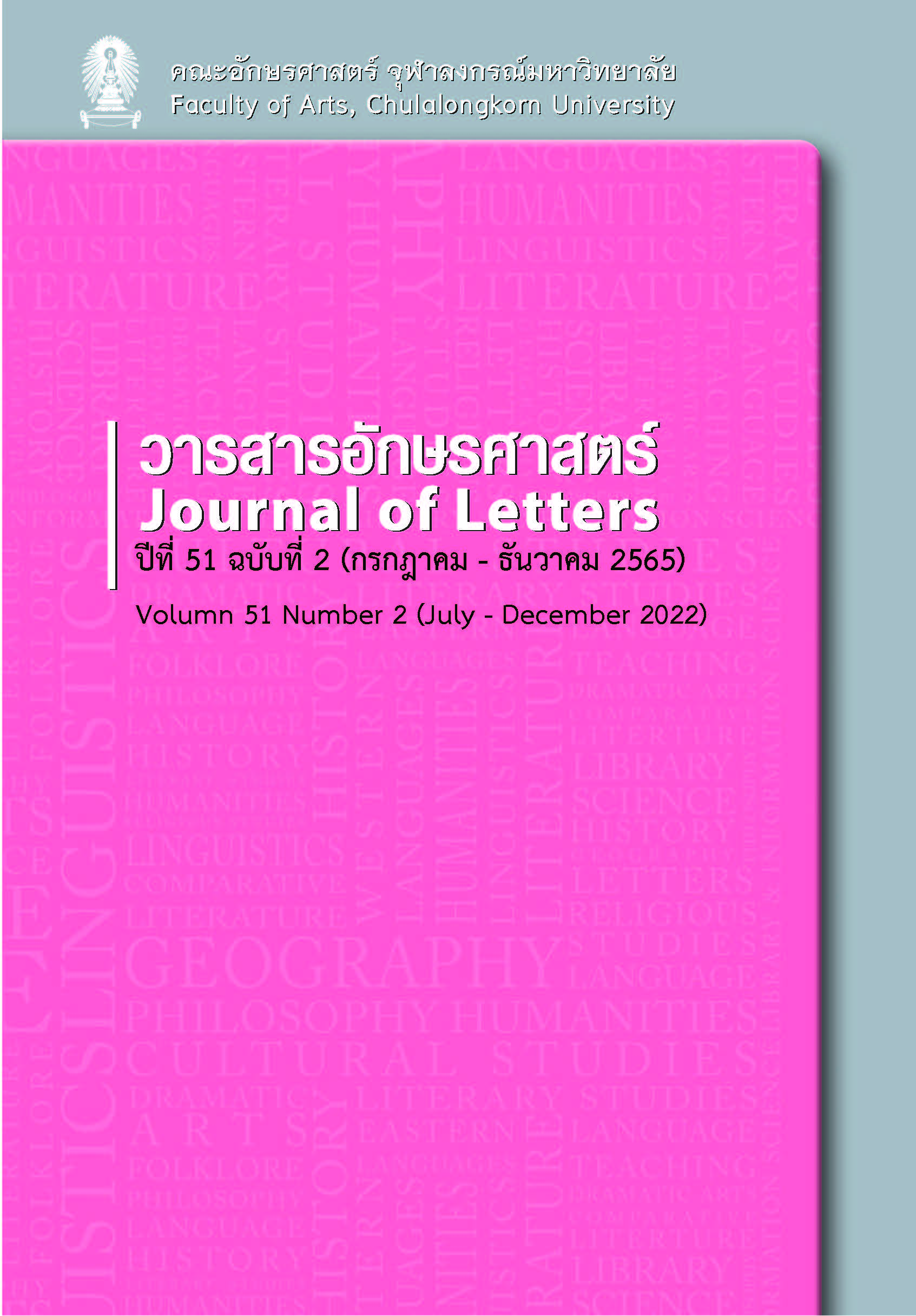The End of the First Love...Marguerite Duras’s The Lover
Keywords:
Twentieth century French novel, Marguerite Duras, The Lover, Theme of love, Narrator’s voiceAbstract
This article attempts to analyze love as one of the major themes in Marguerite Duras’s The Lover and to examine the writing techniques she uses in her novel. The Lover captures the protagonist narrator’s memories of her life as a French turning 16 who lived in Vietnam during the colonial period. The narrator recalled those days when she met a Chinese man with whom she later had a love affair. Recollecting the past enables her not only to reminisce about the first love but also to reconsider her feelings towards, and relationships with, her family members: mother, elder brother and younger brother. She also revealed herself and her dream to become a writer. Love can thus be analyzed from different perspectives which include a variety of the narrator’s relationships with other people in her life.
In terms of the writing techniques Marguerite Duras uses in her novel, the narrative is non-chronological and elliptical, hence being enigmatic to readers. The author employs the first-person pronoun “I” as well as the third-person one “she” and also keeps the narrator nameless, thereby resulting in ambiguity between fact and fiction. The strategy of switching the pronouns used from “I” to “she” creates the narrative distance of author, narrator and protagonist, and adds a sense of the past to the narrative. Incidents and spatio-temporal dimensions in the novel correspond with some details in the autobiography of the French author who spent her youth in Vietnam during the colonial times.
References
ภาษาไทย
Balzac, H. de บัลซัค, อาช. เดอ. (1999). Phor Koriyo พ่อกอริโยต์ [Le Père Goriot] (Ladda Wongsayan & Walaya Wiwatsorn, Trans.). Butterfly.
Duras, M ดูราส, แอม. (1997). Koen kan paesifik เขื่อนกั้นแปซิฟิก [Un barrage contre le Pacifique] (Amphan Otrakul, Trans.). Tantawan.
Duras, M ดูราส, แอม. (1993a). Khon rak chak Kolong คนรักจากโคลอง [L’Amant] (Samporn, Trans.). Chabkrae.
Duras, M ดูราส, แอม. (1993b). Raek rak แรกรัก [The Lover] (Intira, Trans.). Smit.
Thira Suksawasdi Na Ayuthya ธีรา ศุขสวัสดิ์ ณ อยุธยา. (2011). Marguerite Duras raeng bandanjai chak nam su krongsang kwamkid baeb khutrongkham มาร์เกอริต ดูราส แรงบันดาลใจจากน้ำสู่โครงสร้างความคิดแบบคู่ตรงข้าม [Marguerite Duras, the water inspiration as a link to dichotomies]. Manutsayasat san มนุษยศาสตร์สาร [Journal of Human Sciences], 12(1), 16-30.
Thira Suksawasdi Na Ayuthya ธีรา ศุขสวัสดิ์ ณ อยุธยา. (n.d.). Buraphakadiniyom nai wannakam khong Marguerite Duras บูรพคดีนิยมในวรรณกรรมของมาร์เกอริต ดูราส [Orientalism in Marguerite Duras’s literary works] [Research report, Chiang Mai University]. CMUDC. https://cmudc.library.cmu.ac.th/frontend/Info/item/dc:32223
Thira Suksawasdi Na Ayuthya ธีรา สุขสวัสดิ์ ณ อยุธยา. (1999). Mong Indochin chak nangsue song lem khong Marguetire Duras Un Barrage contre le Pacifique (Koen kan paesifik) lae L’Amant (Khon rak chak Kolong) มองอินโดจีนจากหนังสือสองเล่มของมาร์เกอริต ดูราส Un Barrage contre le Pacifique (เขื่อนกั้นแปซิฟิก) และ L’Amant (คนรักจากโคลอง) [Indochina as depicted in Marguerite Duras’s Un Barrage contre le Pacifique and L’Amant]. Silpa wattanatham ศิลปวัฒนธรรม [Art & Culture], 20(9), 148-159.
ภาษาต่างประเทศ
Adler, L. (1998). Marguerite Duras. Gallimard.
Armel, A. (1990). Repères biographiques. Magazine littéraire, 278, 25-27.
Armel, A. (1998). Marguerite Duras. Les trois lieux de l’écrit. Christian Pirot.
Barbéris, D. (1992). Marguerite Duras, Moderato Cantabile / L’Amant. Nathan.
Borgomano, M. (2010). Marguerite Duras. De la forme au sens. L’Harmattan.
Bourgeois, S. (2007). Marguerite Duras. Une écriture de la réparation. L’Harmattan.
Denes, D. (1997). Étude sur Marguerite Duras, L’Amant. Ellipses.
Dunoyer, C., Stolz, Cl., Cavrois, J-M., Degranges, C. D., Tres-Guillaume, M-L. & Molinié, G. (2007).
Nouvelle grammaire du collège, 6e, 5e, 4e, 3e. Magnard.
Duras, M. (1950). Un barrage contre le Pacifique. Coll. Folio. Gallimard.
Duras, M. (1984). L’Amant. Les Éditions de Minuit.
Duras, M. (1991). L’Amant de la Chine du Nord. Coll. Folio. Gallimard.
Lemaitre, H. (1984). L’Aventure littéraire du XXe siècle, 1920-1960. Coll. Littérature. Pierre Bordas et fils.
รูปภาพ
ECLA Aquitaine. (2010). Rencontre de Duras, 14, 15 et 16 mai 2010. Marguerite Duras, alcool et écriture. [Affiche publicitaire]. http://ecla.aquitaine.fr/Agenda-et-actualités/Agenda/Ecrit-et-livre/2010
Français loisir. (2011). [Marguerite Duras dans sa jeunesse, portant un chapeau à l’image de la protagoniste de L’Amant]. https://francaisloisir.blogspot.com/2011/04/marguerite-duras.html
IMDb. (n.d.). [Image publicitaire du film L’Amant : la première rencontre des protagonistes, l’habit de la narratrice-personnage]. https://www.imdb.com/media/rm1717245696/tt0101316
Le spécialiste des chapeaux. (2019). [Le chapeau en feutre, aux bords plats et au large ruban noir, porté par la protagoniste dans le film L’Amant]. http://www.le-chapelier-rodez.com/images/chapeau-l-amant_5.jpg
Le spécialiste des chapeaux. (2019). [Scène tirée du film L’Amant : l’habit et la voiture de luxe du riche chinois, l’amant de la protagoniste]. http://www.le-chapelier-rodez.com/chapeau-lamant/
Downloads
Published
How to Cite
Issue
Section
License

This work is licensed under a Creative Commons Attribution-NonCommercial-NoDerivatives 4.0 International License.
Copyright and plagiarism
Authors are responsible for obtaining permission to use copyrighted materials from copyright owners. Authors are responsible for observing requisite copyright law when quoting or reproducing copyrighted materials. Quotations and reproductions of content from other published sources must be accompanied by a reference and all sources should be clearly listed in the references section. Quotations and reproductions of content from external sources without due attribution could be considered a severe infringement of academic conduct and may constitute a legal offence under the Copyright Act of B.E. 2537. Any legal ramifications arising from the infringement of copyright regulations would be the sole responsibility of the author(s).



